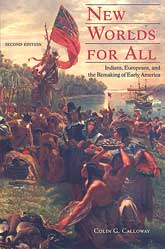 |
 |
|||
New Worlds for All: Indians, Europeans and the Remaking of Early America by Colin Calloway
|
|||
| $27.95 | |||
|
Ranging across the continent and over 300 years, New Worlds for All describes encounters between Spanish conquistadors and Zuni warriors, Huron shamans and French Jesuit missionaries, English merchants and Montagnais Indian traders. Calloway’s discussion of conflict and cooperation includes the use of natural resources and shared knowledge about trail networks, herbal medicines, metal tools, and weapons. He depicts the European emulation of Indian military tactics, the varied responses of Indian societies to Christianity, attempts made on all sides to learn the languages and customs of the other, and the intermingling of peoples at the fringes of competing cultures - through captivity and adoption, attempts to escape one’s own society and embrace another, or intermarriage. The New World, Calloway concludes, brought new identities for all, as Indian and European cultures combined to create a uniquely American identity. Paperback, 2013 2nd edition, 242 pages, b/w illust., index, $27.95 OUT OF STOCK |
|||
|
|
|||
|
©2022 Lord Nelson's
Gallery ~ 717.334.7950 |
|||

 In New Worlds for All, Calloway explores the unique and vibrant new cultures that Indians and Europeans forged together in early America. The process, Calloway writes, lasted longer than the United States has existed as a nation. During that time, most of America was still “Indian country, “ and even in areas of European settlement, Indians and Europeans remained a part of each other’s daily lives: living, working, worshiping, traveling, and trading together as well as fearing, avoiding, despising, and killing one another.
In New Worlds for All, Calloway explores the unique and vibrant new cultures that Indians and Europeans forged together in early America. The process, Calloway writes, lasted longer than the United States has existed as a nation. During that time, most of America was still “Indian country, “ and even in areas of European settlement, Indians and Europeans remained a part of each other’s daily lives: living, working, worshiping, traveling, and trading together as well as fearing, avoiding, despising, and killing one another.